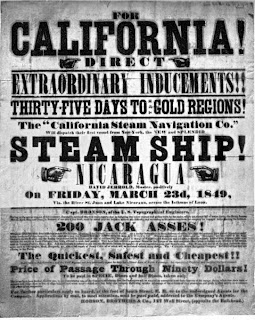Industrial Revolution/Victorian Era:
Steam-Powered Press made by Koenig, 1814
California Goldrush Handbill, 1849
A Pharmaceutical Envelope by the company Walker & Son
A Specimen of Printing Types by William Calson
The Pencil of Nature by William Henry Fox Talbet, 1844
Arts and Crafts Movement:
The Nature of Gothic by John Ruskin, 1892
The Elements of Euclid by William Pickering, 1847
Wren's City Chruches by Arthur H. Mackmurdo, 1883
The Story of the Glittering Plain or The Land of the Living Men, 1891
The Book of Common Paper by William Pickering, 1844
Small Press Movement:
Woody Guthrie Poster by YeeHaw Industries, 2002
Master of Disaster Tour Poster by YeeHaw Industries
The Coalminer's Daughter by YeeHaw Industries, 2006
St. Louis Twangfest by YeeHaw Industries
Barnyard Butcher by YeeHaw Industries
Similarity/Differences Discussion:
The Small Press Movement is our most current, having been developed as. to put simply, the latest version of the Arts and Crafts Movement and the Industrial Revolution/Victorian Era. The main similarity between the current Small Press Movement and The Arts and Crafts Movement involved a better quality of work on the designs themselves, both finding that the mass production that the Industrial Revolution/Victorian Era were downgrading quality. They achieve this quality because of the human element they add working layer by layer on the piece, rather than letting technology do it all. However whereas the Arts and Crafts Movement expanded itself from print to furniture and even to making buildings or homes, the current Small Press Movement stuck itself to print only. A difference the Small Press Movement shares with both the Arts and Crafts Movement and the Industrial Revolution/Victorian Era is the type of design they made; using machines entirely, or more than the human touch, allowed intricate, exciting and often very busy designs to be used in their work. The current Small Press Movement, however, has the human touch applied to each layer made, with machinery helping to bring it to life, and this overall means simpler designs. Another difference both past movements have with our current Small Press Movement is the freedom, or rather power, of expression. A similarity that is held between the current Small Press Movement and the Industrial Revolution/Victorian Era is the use of type; as seen in my examples above, all from YeeHaw Industries, the Small Movement shares the Industrial Revolution's use of bold, colorful typeface that helps the design stand out to others. In the end it is easily seen that the current Small Press Movement has been developed from the Arts and Crafts Movement, and then both the Industrial Revolution and Victorian Era before that, through style design, concept of artwork, and methods of creating the designs.



















